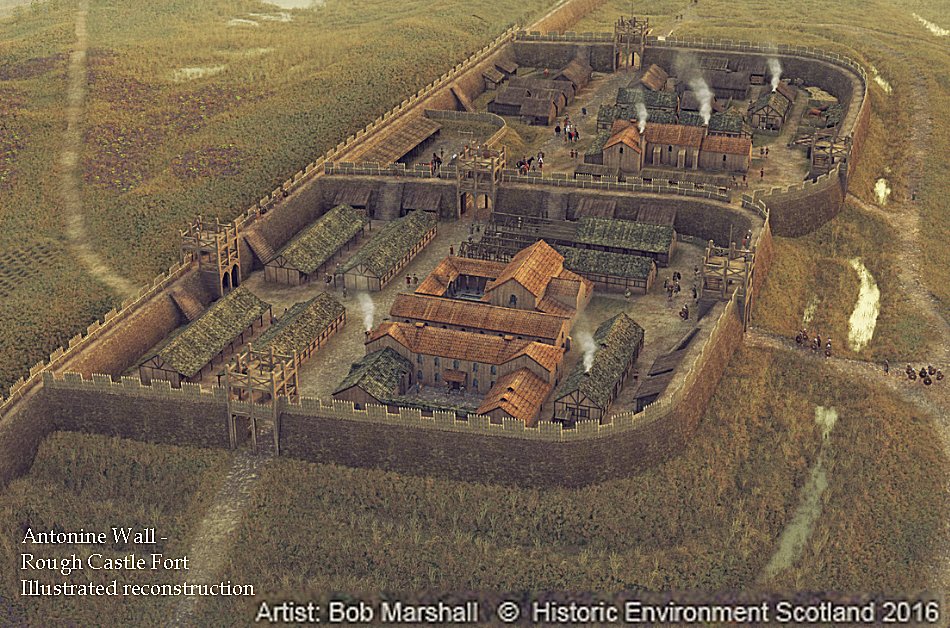Antonine Wall: Impressive Roman Frontier Built By Empire’s Three Legions In Scotland
A. Sutherland - AncientPages.com - The Hadrian Wall lost its importance when Roman Emperor Hadrian's successor, Antonius Pius (138 - 161), launched a successful military campaign in southern Scotland early in his reign and began constructing the Antonine Wall.
Image credit: Artist Bob Marshall - Historic Environment Scotland 2016
The Romans started to build the Antonine Wall in Britain only fifteen years after the
construction of Hadrian's Wall was completed. It is known that the famous Hadrian's Wall was built for both military and economic needs.
The Wall would also prevent raiders from the north from destroying the strategic Roman base at Corbridge in Northumberland.
The Antonine Wall was constructed by another second-century emperor even further north of Hadrian's Wall. The unrest from the north must have been palpable to dictate the construction of such massive formations.
From 155 to 157 CE, the Brigantes revolted in Scotland. They were ancient Britons who, in pre-Roman times, controlled the most extensive section of what would become Northern England -
The Antonine Wall's ruins are less visible than those of the Hadrian's Wall. It is mainly due to the hazardous building material - turf- used to construct the Wall. However, it is evidenced by the construction of foundations that the Romans planned to erect a stone wall.
The soldiers of the Second Augusta, the Sixth Victrix, and the Twentieth Valeria Victrix legions (also responsible for the building of Hadrians Wall) began to construct the Antonine Wall in AD 142 at the order of Roman Emperor Antoninus Pius.
The structure that runs across what is now the Central Belt of Scotland, between the Firth of Forth and the Firth of Clyde, was the Roman Empire's northernmost frontier barrier.
A wooden barrel, with the owner's name, scratched into it. Image credit: Hunterian Museum
The work took about 12 years to complete. These legions erected stone slabs on completion of their work and are the records of the length of the Wall they completed, the emperor's name, and the legion's name.
The slabs are unique because no similar slabs are known from any frontier of the Roman Empire.
Originally six forts were planned (Carriden, Mumrills, Castlecary, Bar Hill, Balmuildy, and Old Kilpatrick), with several fortlets built in between. Later, these fortlets were abandoned, and the next ones were constructed.
The Antonine Wall (named after the Roman emperor Antoninus Pius) was an impressive barrier with a height of 4 meters, 4.3 meters wide, with a large ditch on the north side for reinforcement of defense and a network of roads on the south side for the efficient movement of troops. It was 63 km (39 miles) long, with 19 forts every 3.3 km.
 Left: Found at Carleith, Dunochter, before 1699. Translates as " For the Emperor Antonius Augustus Pius, Father of this country, the Second Augustan Legion completed 3271 feet (of the wall)" Greyish buff sandstone; Right: Unknown provenance - donated to Glasgow University in 1695; Translated as "For the Emperor Caesar Titus Aelius Hadrianus Antoninus Augustus Pius, Father of this Country, a detachment of the Twentieth Valerian and Victorius Legion; Image credit: University of Glasgow, Scotland
Left: Found at Carleith, Dunochter, before 1699. Translates as " For the Emperor Antonius Augustus Pius, Father of this country, the Second Augustan Legion completed 3271 feet (of the wall)" Greyish buff sandstone; Right: Unknown provenance - donated to Glasgow University in 1695; Translated as "For the Emperor Caesar Titus Aelius Hadrianus Antoninus Augustus Pius, Father of this Country, a detachment of the Twentieth Valerian and Victorius Legion; Image credit: University of Glasgow, Scotland
As early as 162 AD (only eight years after its completion), the Romans from this line were forced to retreat to the south again and return to the older fortification - Hadrian's Wall - after it was strengthened.
Unfortunately for the Romans, the Wall was abandoned, recaptured a year later, and finally, entirely abandoned by 164 CE.
Left: Altar to ‘the Spirit of the Land of Britain’. © Hunterian Museum; Right: Tombstone of Verecunda © Hunterian Museum
Archaeological excavation conducted in the ruins of the Wall revealed many Roman artifacts, both military and domestic. When the Romans abandoned a fort, they usually buried many possessions they did not wish to salvage and take with them. They did not want them to be used by local people.
Except for decorative slabs, the Romans also left altars, tombstones, personal possessions, and building materials, which were well-preserved, well-buried, and, therefore, never touched by robbers.
Written by – A. Sutherland AncientPages.com Staff Writer
Updated on April 18, 2023
Copyright © AncientPages.com All rights reserved. This material may not be published, broadcast, rewritten or redistributed in whole or part without the express written permission of AncientPages.com
Expand for referencesReferences:
Harper W. The Antonine Wall (Defenders of Rome, Book 4)
More From Ancient Pages
-
 The Mixtec – Mysterious Very Advanced Culture Of The Foremost Goldsmiths Of Mesoamerica
Civilizations | Dec 2, 2017
The Mixtec – Mysterious Very Advanced Culture Of The Foremost Goldsmiths Of Mesoamerica
Civilizations | Dec 2, 2017 -
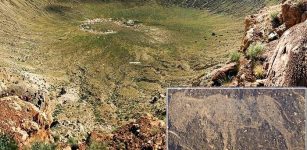 8,000-Year-Old Petroglyphs Discovered In Oldest Impact Crater In South Africa
Archaeology | Jun 21, 2019
8,000-Year-Old Petroglyphs Discovered In Oldest Impact Crater In South Africa
Archaeology | Jun 21, 2019 -
 Rare Bulla (Seal) And 2,600-Year-Old Stamp With Biblical Name Unearthed In City Of David
Archaeology | Apr 3, 2019
Rare Bulla (Seal) And 2,600-Year-Old Stamp With Biblical Name Unearthed In City Of David
Archaeology | Apr 3, 2019 -
 Choctaw Indians’ Legend Of Nanih Waiya Cave Mound – Mysterious Underground Realm Of Their Ancestors And Their Battle With Giants
Ancient Mysteries | Aug 3, 2017
Choctaw Indians’ Legend Of Nanih Waiya Cave Mound – Mysterious Underground Realm Of Their Ancestors And Their Battle With Giants
Ancient Mysteries | Aug 3, 2017 -
 Oldest Sea Reptile From Age Of Dinosaurs Found On A Remote Arctic Island
News | Apr 3, 2023
Oldest Sea Reptile From Age Of Dinosaurs Found On A Remote Arctic Island
News | Apr 3, 2023 -
 First Evidence Of Canoe Burial With Remains Of A Woman Discovered In Argentinian Patagonia
Archaeology | Aug 27, 2022
First Evidence Of Canoe Burial With Remains Of A Woman Discovered In Argentinian Patagonia
Archaeology | Aug 27, 2022 -
 Great Wall Of India: Massive Structure That Surrounds Ancient Fort Of Kumbhalgarh
Featured Stories | Aug 31, 2015
Great Wall Of India: Massive Structure That Surrounds Ancient Fort Of Kumbhalgarh
Featured Stories | Aug 31, 2015 -
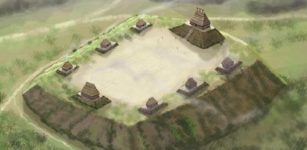 Emerald Mound In The Ancient City Of Natchez: Second Largest Temple Mound In North America
Featured Stories | Feb 22, 2018
Emerald Mound In The Ancient City Of Natchez: Second Largest Temple Mound In North America
Featured Stories | Feb 22, 2018 -
 Athena – Goddess Of Wisdom Delivered Punishments And Gifts
Featured Stories | Dec 31, 2018
Athena – Goddess Of Wisdom Delivered Punishments And Gifts
Featured Stories | Dec 31, 2018 -
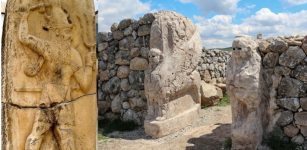 Drought Accelerated Hittite Empire Collapse – New Study Suggests
Archaeology | Feb 12, 2023
Drought Accelerated Hittite Empire Collapse – New Study Suggests
Archaeology | Feb 12, 2023 -
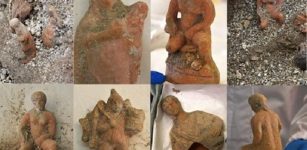 13 Ancient Terracotta Figurines Associated With Cybele And Attis Unearthed In Pompeii
Archaeology | Dec 28, 2023
13 Ancient Terracotta Figurines Associated With Cybele And Attis Unearthed In Pompeii
Archaeology | Dec 28, 2023 -
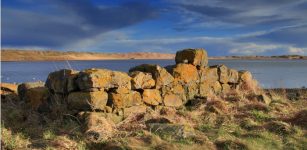 Clues What Tiggered Climate Change 8,000 Years Ago Found In Scotland
News | Sep 15, 2023
Clues What Tiggered Climate Change 8,000 Years Ago Found In Scotland
News | Sep 15, 2023 -
 Nurikabe: Trickster That Manifests Itself As Invisible, Impassable Wall In Japanese Old Beliefs
Featured Stories | Oct 21, 2019
Nurikabe: Trickster That Manifests Itself As Invisible, Impassable Wall In Japanese Old Beliefs
Featured Stories | Oct 21, 2019 -
 Oldest Evidence To Date: 80,000-Year-Old Stone Blades Of Homo Sapiens Found In Jebel Faya, Arabia
Archaeology | Feb 19, 2025
Oldest Evidence To Date: 80,000-Year-Old Stone Blades Of Homo Sapiens Found In Jebel Faya, Arabia
Archaeology | Feb 19, 2025 -
 On This Day In History: Western Roman Emperor Severus II Died – On Sep 16, 307
News | Sep 16, 2016
On This Day In History: Western Roman Emperor Severus II Died – On Sep 16, 307
News | Sep 16, 2016 -
 Fragment Of A Fine Marble Statuette Of Heracles Found In Jezreel Valley, Israel
Archaeology | May 24, 2023
Fragment Of A Fine Marble Statuette Of Heracles Found In Jezreel Valley, Israel
Archaeology | May 24, 2023 -
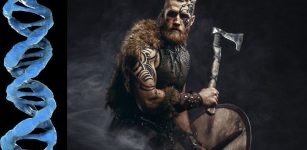 World’s Largest DNA Study Of Viking Skeletons Re-Writes Ancient History – Norse Warriors Were Not Those Who We Thought
Archaeology | Sep 16, 2020
World’s Largest DNA Study Of Viking Skeletons Re-Writes Ancient History – Norse Warriors Were Not Those Who We Thought
Archaeology | Sep 16, 2020 -
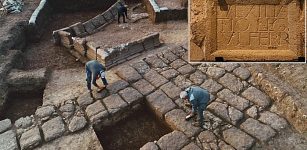 1,800-Year-Old Legio VI Ferrata Military Camp Uncovered In Israel
Archaeology | Feb 21, 2024
1,800-Year-Old Legio VI Ferrata Military Camp Uncovered In Israel
Archaeology | Feb 21, 2024 -
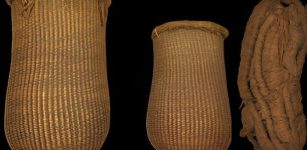 9,500-Year-Old Baskets And 6,200-Year-Old Sandals Found In Spanish Cave
Archaeology | Sep 28, 2023
9,500-Year-Old Baskets And 6,200-Year-Old Sandals Found In Spanish Cave
Archaeology | Sep 28, 2023 -
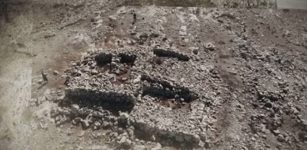 Controversial ‘Anomaly’ Discovered On Mount Ebal Could Be Biblical Joshua’s Altar
Biblical Mysteries | Apr 6, 2020
Controversial ‘Anomaly’ Discovered On Mount Ebal Could Be Biblical Joshua’s Altar
Biblical Mysteries | Apr 6, 2020

